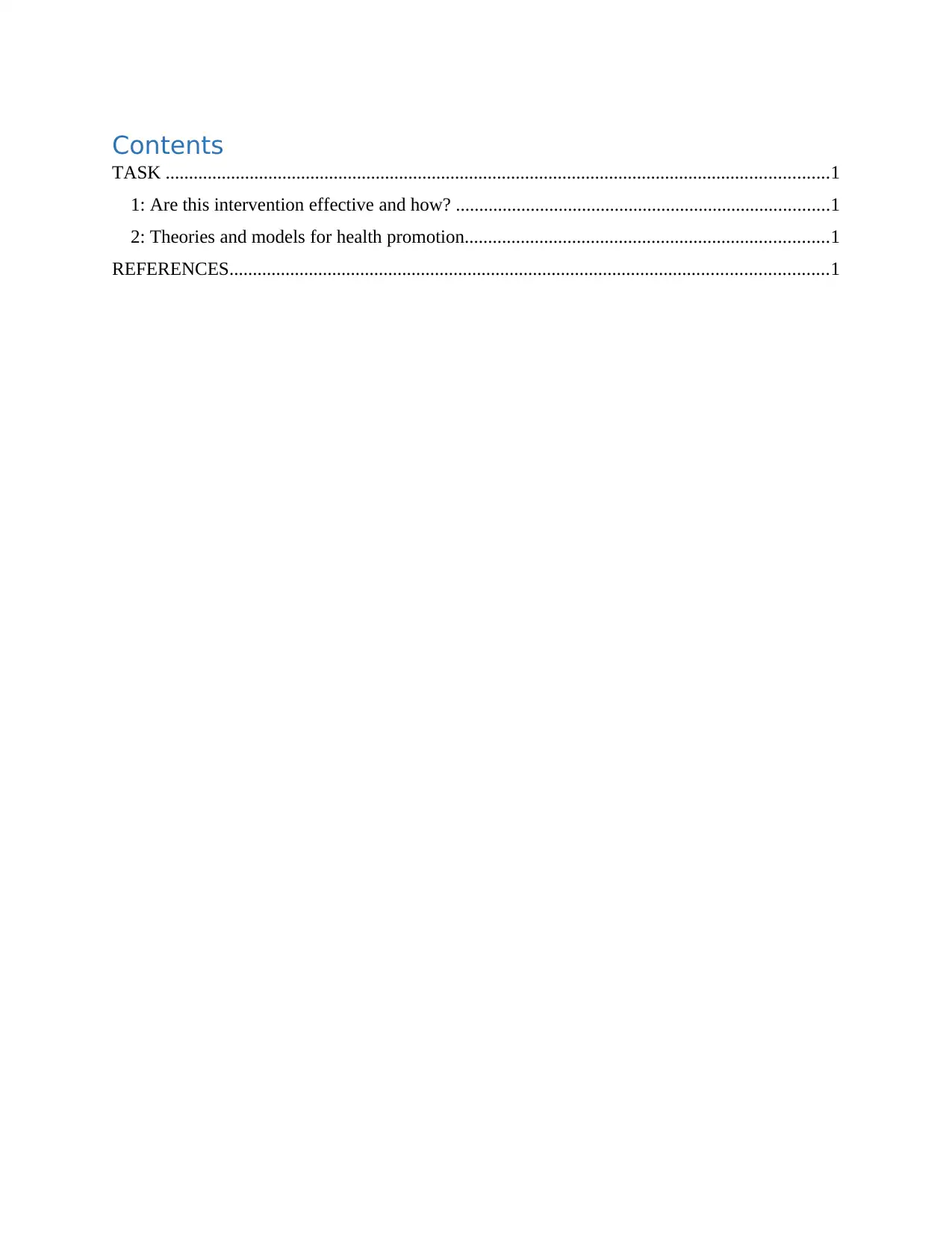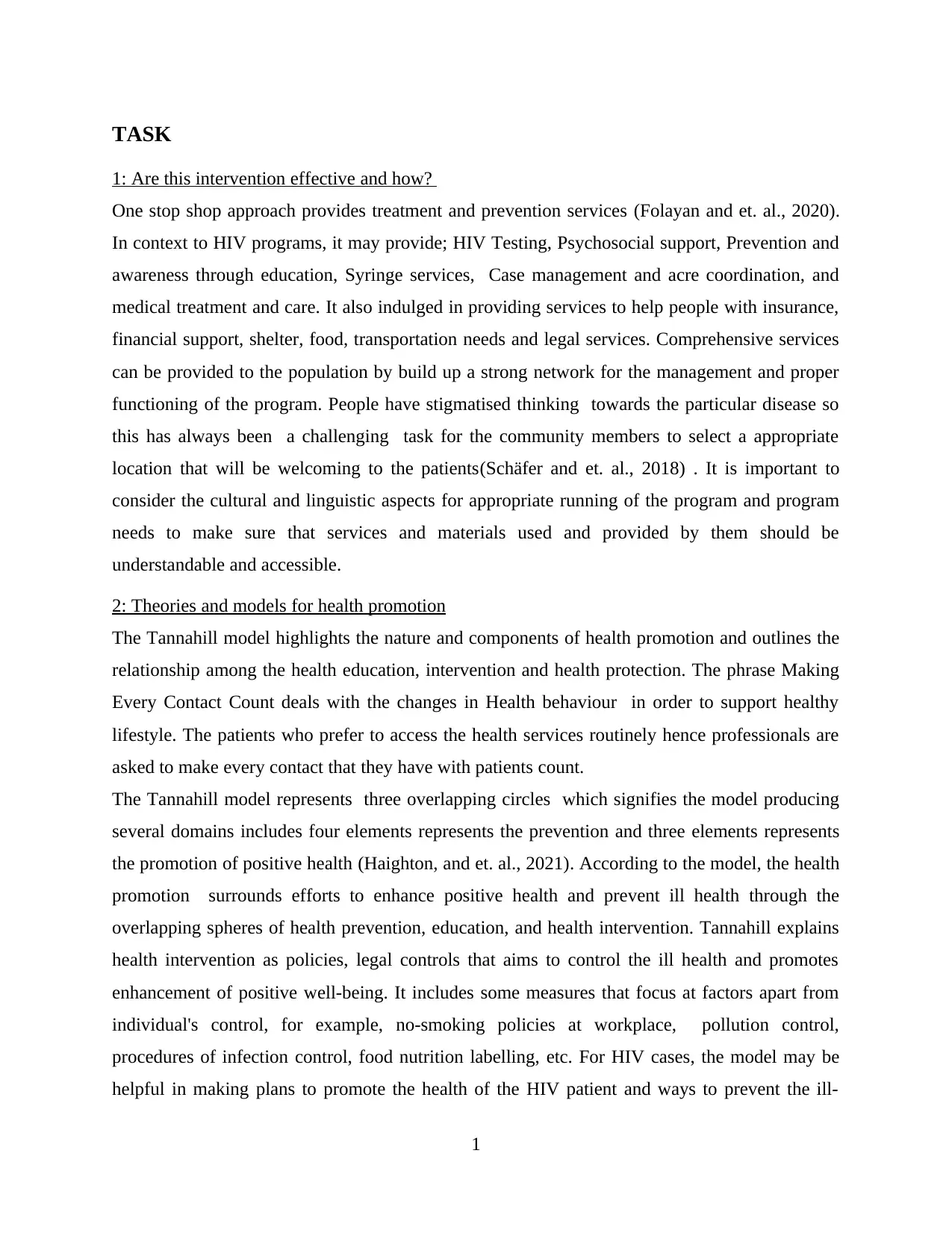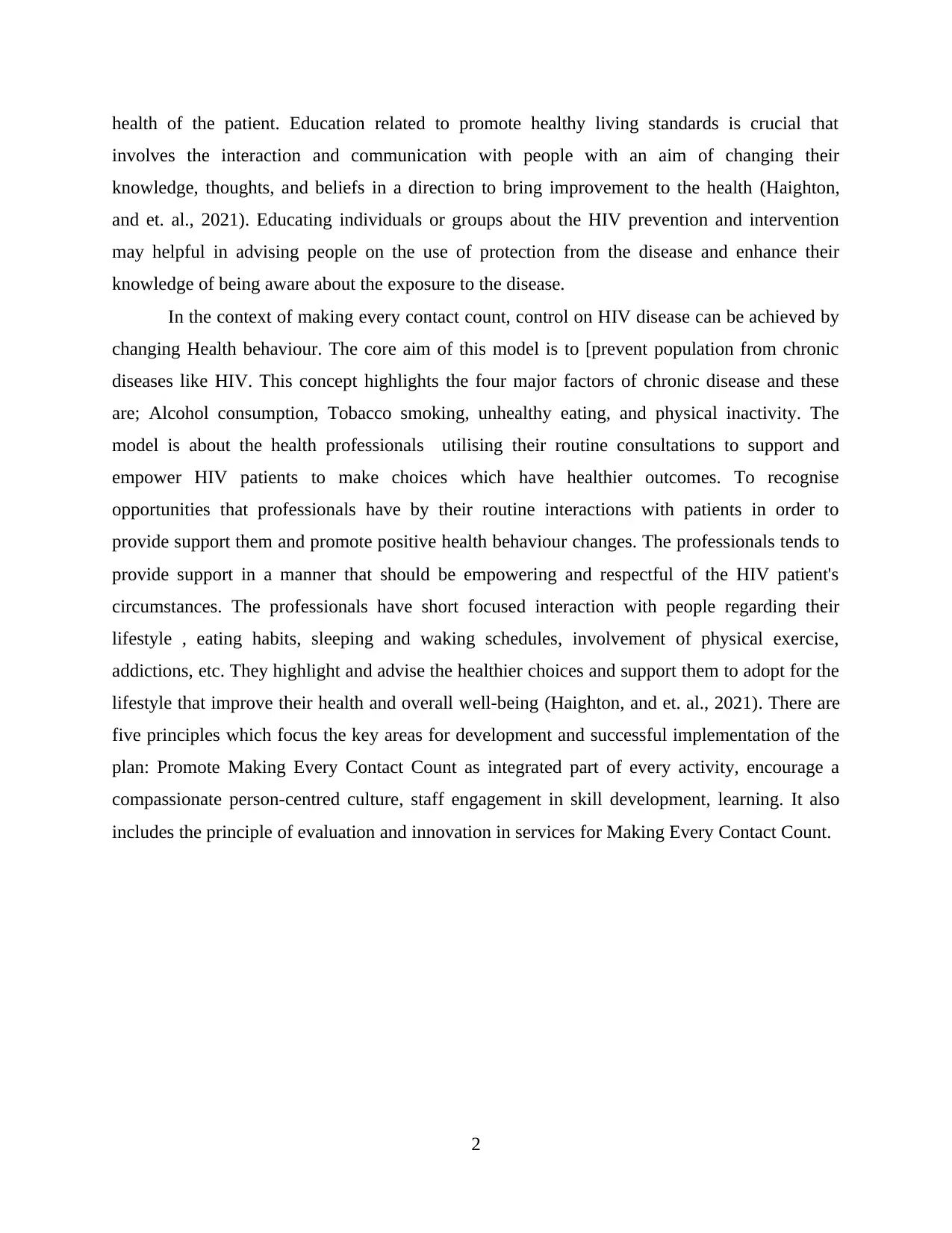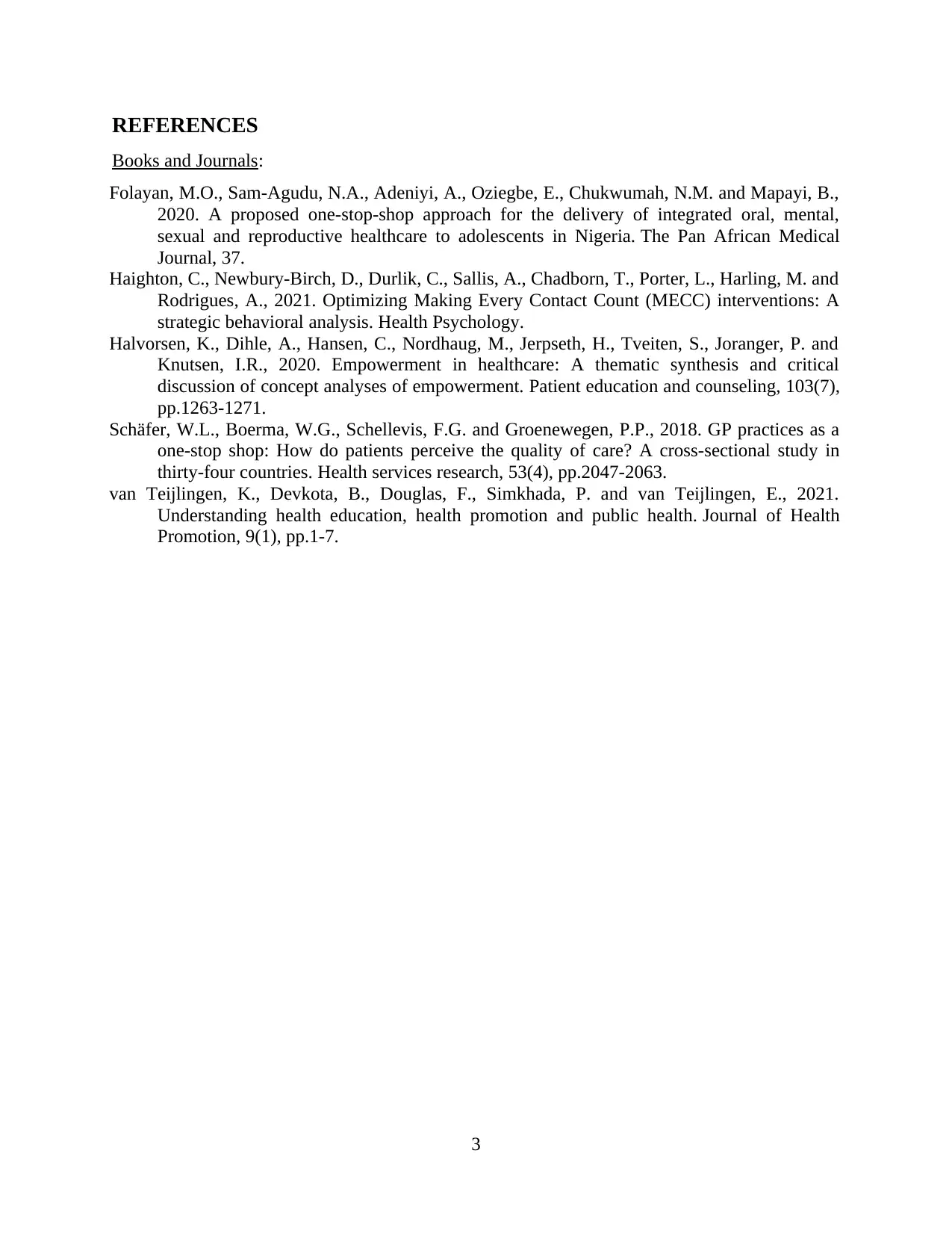Project Analysis: Effectiveness of HIV Interventions and Models
VerifiedAdded on 2023/06/08
|5
|1083
|301
Project
AI Summary
This project analyzes the effectiveness of HIV interventions, focusing on the one-stop-shop approach for providing treatment and prevention services, including HIV testing, psychosocial support, and education. It examines the challenges of stigma and the importance of cultural and linguistic sensitivity in program implementation. The project then delves into health promotion models, particularly the Tannahill model, which highlights the interconnectedness of health education, intervention, and health protection. It discusses the concept of "Making Every Contact Count" in promoting healthy lifestyles and preventing chronic diseases, emphasizing the role of healthcare professionals in supporting patients' behavior changes. The project references key literature and emphasizes the application of these models in HIV prevention and intervention strategies. It includes a discussion of the principles for successful implementation, such as promoting a compassionate, person-centered culture and encouraging staff skill development.

PROJECT
Paraphrase This Document
Need a fresh take? Get an instant paraphrase of this document with our AI Paraphraser

Contents
TASK ..............................................................................................................................................1
1: Are this intervention effective and how? ................................................................................1
2: Theories and models for health promotion..............................................................................1
REFERENCES................................................................................................................................1
TASK ..............................................................................................................................................1
1: Are this intervention effective and how? ................................................................................1
2: Theories and models for health promotion..............................................................................1
REFERENCES................................................................................................................................1

TASK
1: Are this intervention effective and how?
One stop shop approach provides treatment and prevention services (Folayan and et. al., 2020).
In context to HIV programs, it may provide; HIV Testing, Psychosocial support, Prevention and
awareness through education, Syringe services, Case management and acre coordination, and
medical treatment and care. It also indulged in providing services to help people with insurance,
financial support, shelter, food, transportation needs and legal services. Comprehensive services
can be provided to the population by build up a strong network for the management and proper
functioning of the program. People have stigmatised thinking towards the particular disease so
this has always been a challenging task for the community members to select a appropriate
location that will be welcoming to the patients(Schäfer and et. al., 2018) . It is important to
consider the cultural and linguistic aspects for appropriate running of the program and program
needs to make sure that services and materials used and provided by them should be
understandable and accessible.
2: Theories and models for health promotion
The Tannahill model highlights the nature and components of health promotion and outlines the
relationship among the health education, intervention and health protection. The phrase Making
Every Contact Count deals with the changes in Health behaviour in order to support healthy
lifestyle. The patients who prefer to access the health services routinely hence professionals are
asked to make every contact that they have with patients count.
The Tannahill model represents three overlapping circles which signifies the model producing
several domains includes four elements represents the prevention and three elements represents
the promotion of positive health (Haighton, and et. al., 2021). According to the model, the health
promotion surrounds efforts to enhance positive health and prevent ill health through the
overlapping spheres of health prevention, education, and health intervention. Tannahill explains
health intervention as policies, legal controls that aims to control the ill health and promotes
enhancement of positive well-being. It includes some measures that focus at factors apart from
individual's control, for example, no-smoking policies at workplace, pollution control,
procedures of infection control, food nutrition labelling, etc. For HIV cases, the model may be
helpful in making plans to promote the health of the HIV patient and ways to prevent the ill-
1
1: Are this intervention effective and how?
One stop shop approach provides treatment and prevention services (Folayan and et. al., 2020).
In context to HIV programs, it may provide; HIV Testing, Psychosocial support, Prevention and
awareness through education, Syringe services, Case management and acre coordination, and
medical treatment and care. It also indulged in providing services to help people with insurance,
financial support, shelter, food, transportation needs and legal services. Comprehensive services
can be provided to the population by build up a strong network for the management and proper
functioning of the program. People have stigmatised thinking towards the particular disease so
this has always been a challenging task for the community members to select a appropriate
location that will be welcoming to the patients(Schäfer and et. al., 2018) . It is important to
consider the cultural and linguistic aspects for appropriate running of the program and program
needs to make sure that services and materials used and provided by them should be
understandable and accessible.
2: Theories and models for health promotion
The Tannahill model highlights the nature and components of health promotion and outlines the
relationship among the health education, intervention and health protection. The phrase Making
Every Contact Count deals with the changes in Health behaviour in order to support healthy
lifestyle. The patients who prefer to access the health services routinely hence professionals are
asked to make every contact that they have with patients count.
The Tannahill model represents three overlapping circles which signifies the model producing
several domains includes four elements represents the prevention and three elements represents
the promotion of positive health (Haighton, and et. al., 2021). According to the model, the health
promotion surrounds efforts to enhance positive health and prevent ill health through the
overlapping spheres of health prevention, education, and health intervention. Tannahill explains
health intervention as policies, legal controls that aims to control the ill health and promotes
enhancement of positive well-being. It includes some measures that focus at factors apart from
individual's control, for example, no-smoking policies at workplace, pollution control,
procedures of infection control, food nutrition labelling, etc. For HIV cases, the model may be
helpful in making plans to promote the health of the HIV patient and ways to prevent the ill-
1
⊘ This is a preview!⊘
Do you want full access?
Subscribe today to unlock all pages.

Trusted by 1+ million students worldwide

health of the patient. Education related to promote healthy living standards is crucial that
involves the interaction and communication with people with an aim of changing their
knowledge, thoughts, and beliefs in a direction to bring improvement to the health (Haighton,
and et. al., 2021). Educating individuals or groups about the HIV prevention and intervention
may helpful in advising people on the use of protection from the disease and enhance their
knowledge of being aware about the exposure to the disease.
In the context of making every contact count, control on HIV disease can be achieved by
changing Health behaviour. The core aim of this model is to [prevent population from chronic
diseases like HIV. This concept highlights the four major factors of chronic disease and these
are; Alcohol consumption, Tobacco smoking, unhealthy eating, and physical inactivity. The
model is about the health professionals utilising their routine consultations to support and
empower HIV patients to make choices which have healthier outcomes. To recognise
opportunities that professionals have by their routine interactions with patients in order to
provide support them and promote positive health behaviour changes. The professionals tends to
provide support in a manner that should be empowering and respectful of the HIV patient's
circumstances. The professionals have short focused interaction with people regarding their
lifestyle , eating habits, sleeping and waking schedules, involvement of physical exercise,
addictions, etc. They highlight and advise the healthier choices and support them to adopt for the
lifestyle that improve their health and overall well-being (Haighton, and et. al., 2021). There are
five principles which focus the key areas for development and successful implementation of the
plan: Promote Making Every Contact Count as integrated part of every activity, encourage a
compassionate person-centred culture, staff engagement in skill development, learning. It also
includes the principle of evaluation and innovation in services for Making Every Contact Count.
2
involves the interaction and communication with people with an aim of changing their
knowledge, thoughts, and beliefs in a direction to bring improvement to the health (Haighton,
and et. al., 2021). Educating individuals or groups about the HIV prevention and intervention
may helpful in advising people on the use of protection from the disease and enhance their
knowledge of being aware about the exposure to the disease.
In the context of making every contact count, control on HIV disease can be achieved by
changing Health behaviour. The core aim of this model is to [prevent population from chronic
diseases like HIV. This concept highlights the four major factors of chronic disease and these
are; Alcohol consumption, Tobacco smoking, unhealthy eating, and physical inactivity. The
model is about the health professionals utilising their routine consultations to support and
empower HIV patients to make choices which have healthier outcomes. To recognise
opportunities that professionals have by their routine interactions with patients in order to
provide support them and promote positive health behaviour changes. The professionals tends to
provide support in a manner that should be empowering and respectful of the HIV patient's
circumstances. The professionals have short focused interaction with people regarding their
lifestyle , eating habits, sleeping and waking schedules, involvement of physical exercise,
addictions, etc. They highlight and advise the healthier choices and support them to adopt for the
lifestyle that improve their health and overall well-being (Haighton, and et. al., 2021). There are
five principles which focus the key areas for development and successful implementation of the
plan: Promote Making Every Contact Count as integrated part of every activity, encourage a
compassionate person-centred culture, staff engagement in skill development, learning. It also
includes the principle of evaluation and innovation in services for Making Every Contact Count.
2
Paraphrase This Document
Need a fresh take? Get an instant paraphrase of this document with our AI Paraphraser

REFERENCES
Books and Journals:
Folayan, M.O., Sam-Agudu, N.A., Adeniyi, A., Oziegbe, E., Chukwumah, N.M. and Mapayi, B.,
2020. A proposed one-stop-shop approach for the delivery of integrated oral, mental,
sexual and reproductive healthcare to adolescents in Nigeria. The Pan African Medical
Journal, 37.
Haighton, C., Newbury-Birch, D., Durlik, C., Sallis, A., Chadborn, T., Porter, L., Harling, M. and
Rodrigues, A., 2021. Optimizing Making Every Contact Count (MECC) interventions: A
strategic behavioral analysis. Health Psychology.
Halvorsen, K., Dihle, A., Hansen, C., Nordhaug, M., Jerpseth, H., Tveiten, S., Joranger, P. and
Knutsen, I.R., 2020. Empowerment in healthcare: A thematic synthesis and critical
discussion of concept analyses of empowerment. Patient education and counseling, 103(7),
pp.1263-1271.
Schäfer, W.L., Boerma, W.G., Schellevis, F.G. and Groenewegen, P.P., 2018. GP practices as a
one‐stop shop: How do patients perceive the quality of care? A cross‐sectional study in
thirty‐four countries. Health services research, 53(4), pp.2047-2063.
van Teijlingen, K., Devkota, B., Douglas, F., Simkhada, P. and van Teijlingen, E., 2021.
Understanding health education, health promotion and public health. Journal of Health
Promotion, 9(1), pp.1-7.
3
Books and Journals:
Folayan, M.O., Sam-Agudu, N.A., Adeniyi, A., Oziegbe, E., Chukwumah, N.M. and Mapayi, B.,
2020. A proposed one-stop-shop approach for the delivery of integrated oral, mental,
sexual and reproductive healthcare to adolescents in Nigeria. The Pan African Medical
Journal, 37.
Haighton, C., Newbury-Birch, D., Durlik, C., Sallis, A., Chadborn, T., Porter, L., Harling, M. and
Rodrigues, A., 2021. Optimizing Making Every Contact Count (MECC) interventions: A
strategic behavioral analysis. Health Psychology.
Halvorsen, K., Dihle, A., Hansen, C., Nordhaug, M., Jerpseth, H., Tveiten, S., Joranger, P. and
Knutsen, I.R., 2020. Empowerment in healthcare: A thematic synthesis and critical
discussion of concept analyses of empowerment. Patient education and counseling, 103(7),
pp.1263-1271.
Schäfer, W.L., Boerma, W.G., Schellevis, F.G. and Groenewegen, P.P., 2018. GP practices as a
one‐stop shop: How do patients perceive the quality of care? A cross‐sectional study in
thirty‐four countries. Health services research, 53(4), pp.2047-2063.
van Teijlingen, K., Devkota, B., Douglas, F., Simkhada, P. and van Teijlingen, E., 2021.
Understanding health education, health promotion and public health. Journal of Health
Promotion, 9(1), pp.1-7.
3
1 out of 5
Related Documents
Your All-in-One AI-Powered Toolkit for Academic Success.
+13062052269
info@desklib.com
Available 24*7 on WhatsApp / Email
![[object Object]](/_next/static/media/star-bottom.7253800d.svg)
Unlock your academic potential
Copyright © 2020–2025 A2Z Services. All Rights Reserved. Developed and managed by ZUCOL.




